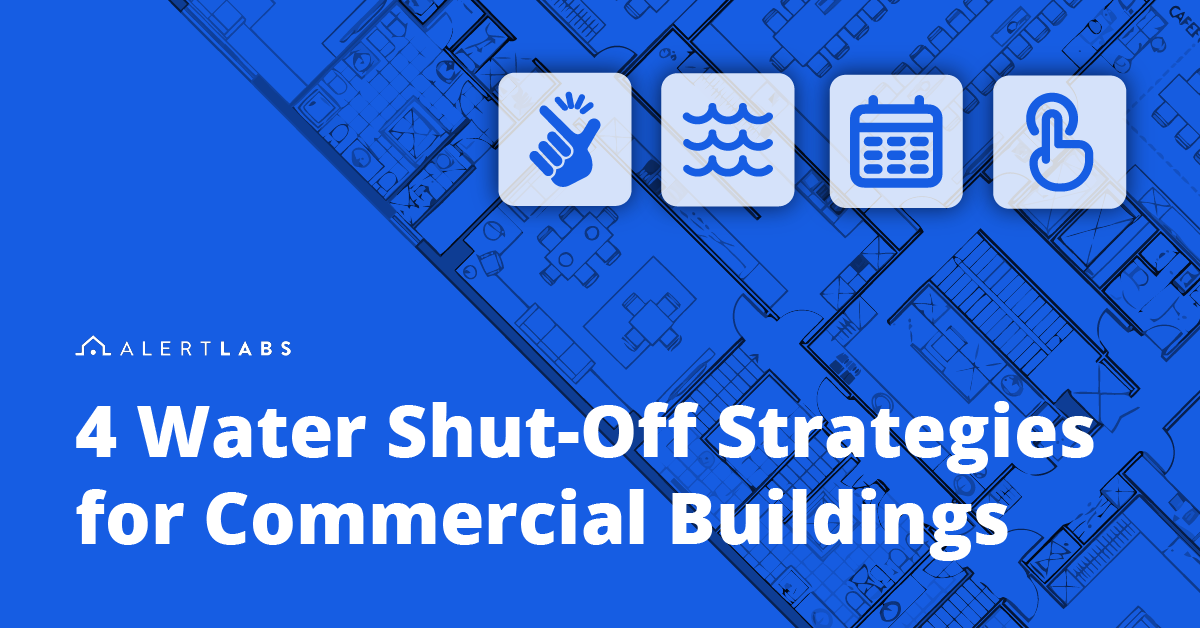4 Water Shut-Off Strategies for Commercial Buildings

Water damage is one of the most expensive and disruptive risks facing commercial buildings. It’s about more than just burst pipes. Water damage interferes with operations, tenant satisfaction, infrastructural integrity, and insurance claims. In construction alone, water damage accounts for a significant portion of property losses. According to Nationwide’s risk management team, 40% of general liability property damage claims are water-related—and many happen when no one is around to respond.
Want to hear how construction leaders and insurers are tackling this?
Our recent webinar features experts from Nationwide Insurance, BGIS, and Alert Labs sharing real-world examples of how water damage was prevented at commercial buildings, sometimes saving six figures in losses.

Why Leak Detection Alone Isn’t Enough
Leak detection is a critical first step in protecting your buildings, but it’s only part of the solution. Once a leak is detected, the next question is: how fast can you stop the water? Every minute counts. A slow response can turn a minor issue into a major loss, especially in buildings with aging infrastructure or critical systems.
That’s why smart water shut-off strategies are essential. They give building operators the ability to control water flow proactively, whether through automation, scheduling, or remote access.
The 4 Water Shut-Off Strategies That Make a Difference
1. Remote Water Shut-Off: Control from Anywhere
Remote shut-off allows operators to turn water on or off from a smartphone or computer. This is especially useful in buildings where valves are hard to access or when maintenance teams are off-site. During the webinar (linked above), you’ll see how remote shut-off has evolved to support larger valve sizes and traceability features.
Hear the full story in the webinar.
Remote water shut-off deployment examples:
- Construction sites
- Retail stores
- Office towers with centralized plumbing
2. Scheduled Water Shut-Off: Automate Downtime Protection
Scheduled shut-off lets you automate water control based on predictable usage or occupancy patterns. For example, water can be turned off at 6 p.m. and back on at 6 a.m., with weekends fully shut down. This strategy is especially effective in schools, retail spaces, and construction sites, where human error (like forgetting to shut off water before leaving) is all-too common and can lead to significant water damage.
Scheduled water shut-off deployment examples:
- Vacant units or buildings
- Seasonal properties
- Construction sites (after hours)
3. Automatic Water Shut-Off: Instant Response to Leaks
Automatic shut-off uses leak detectors to trigger valve closure the moment water is detected where it shouldn’t be. It’s the fastest way to stop damage and is highly customizable. In condo buildings, for example, leak sensors in each unit can be set up to automatically shut off that unit’s water supply. In larger facilities, sensors can be tied to zones, risers, or mechanical rooms.
Automatic water shut-off deployment examples:
- Unattended or vacant properties
- Mechanical rooms, water heaters, and basements
- Insurance compliance
Webinar story you don’t want to miss:
“[Without Alert Labs shut-off solutions] the water would have flown for probably 10 hours plus... Average losses in a bank branch are around $30k [but they could have been] over a $100k.”
Q&A insight:
Concerned about alarms from non-leak events like a wet mop? The system includes a notification delay feature. If water contact ends within a few minutes, the valve won’t shut off—avoiding unnecessary disruptions.
4. Flow-Based Water Shut-Off: AI-Powered Prevention
This strategy uses smart water flow monitoring to detect abnormal water usage patterns. If a spike occurs from a continuously running intake line, for example, the system can shut off water automatically.
How it works:
- AI compares current usage to historical data and similar buildings
- Sensitivity settings allow customization
- Alerts can be tied to specific zones or whole-building shut-off
Flow-based water shut-off deployment examples:
- Data centers and telecom buildings
- Complex plumbing systems
- High-value infrastructure
Webinar Q&A insight:
- A condo unit with water flow monitoring on its branch line can detect a left-on shower even if no flooding occurs
- Cooling towers can be monitored via flow sensors on makeup water lines and blowdown systems
Things to Consider Before Choosing a Smart Water Shut-Off Strategy
Not every building can support every water shut-off method. Here are a few factors to evaluate:
- Infrastructure age: Older pipes may not tolerate frequent shut-offs
- Critical systems: Hospitals and data centers may require zone-based control
- Fire suppression: Shut-off valves must never be installed on life safety systems
Operationalizing Your Strategy
Technology is only as effective as the team using it. That’s why Alert Labs emphasizes the importance of standard operating procedures (SOPs) and offers onboarding training and support to ensure customer success.
- What each alert means
- Who gets notified (SMS, email, dashboard)
- Who responds during business hours vs. after-hours
Webinar insight:
Alert Labs shut-off valves perform automated cleaning cycles every two weeks to prevent sediment buildup—no manual servicing required.
Final Thoughts: Prevention Is a Strategy
Water damage doesn’t wait. Whether you’re managing a condo tower, a retail bank, or a construction site, the right shut-off strategy can mean the difference between a minor inconvenience and a major loss. The best approach combines detection, automation, and human oversight—tailored to your building’s needs.



